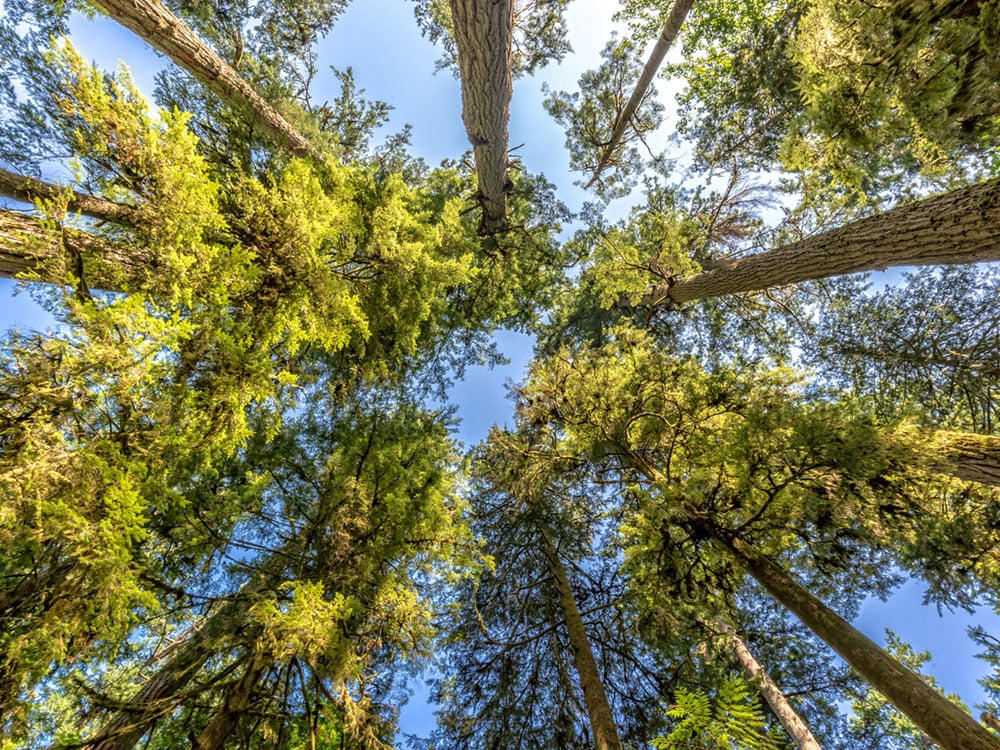The B.C. government has committed $15 million over the next three years through its CleanBC fund to fertilize 25,000 hectares of the province’s temperate rainforests with urea, a nitrogen fertilizer synthesized to mimic animal pee.
This strategy will help forests absorb an additional 1.3 million metric tonnes of carbon dioxide by 2030, the Ministry of Forests said in an email to The Tyee, because fertilizing young stands of trees that have been logged or burned within the last 25 years makes them grow faster, thereby absorbing CO2 faster.
When the government first announced this initiative in late April, it said it would spend $15 million fertilizing 8,500 hectares that would result in 3.7 million tonnes of CO2 being absorbed by 2030.
That’s some impressive fertilizer — in that scenario, every hectare of fertilized forest would have absorbed 435 tonnes of extra CO2 over the next eight years. On May 4 the government changed the numbers to say it would spend the same amount of money to fertilize 25,000 hectares, thereby absorbing 1.3 million tonnes of CO2 by 2030 — which means each fertilized hectare would absorb an additional 52 tonnes of CO2.
The Ministry of Forests did not reply to questions about how increasing the amount of forest fertilized would reduce the overall amount of CO2 absorbed. But an earlier email did note emissions reductions calculations can change “as research, carbon modelling methods, data and information changes.”
The forests the government plans to fertilize are located in the coastal and Interior wet belt and have been chosen based on species composition, age and site index, amongst other factors, the Ministry of Forests said in an email.
The funds will not go towards protecting old-growth forests or even trees in parks. Old-growth forests will not be fertilized because “by that age there is essentially no carbon benefit to fertilization,” and parks won’t be fertilized because “treatments do not fall within the mandate of park management,” the Ministry of Forests said.
Instead, “most” of the trees that will be fertilized will fall within the Timber Harvesting Land Base and could be logged 10 years after fertilization, because “10 years is required for a maximum carbon benefit return,” the Ministry of Forests said. “After that some will be harvested and some will not. It will depend on normal harvesting methods.”
B.C. has been fertilizing its second and third-growth forests “for decades” because a single nitrogen dose (a nutrient B.C.’s forests have low amounts of) can “boost growth by roughly 30 to 15 cubic metres of wood per hectare,” according to the government.
B.C. has been fertilizing its forests since 1978 and today, through its Forest Carbon Initiative, fertilizes around 17,000 hectares annually.
The difference with this year’s plan is that some of the fertilization funds are coming from CleanBC, the province’s strategy for fighting climate change.
CleanBC’s contribution to the pot joins an additional $18 million of funding being allotted to fertilization this year, the ministry told The Tyee via email. “If this is amount is continued annually, there would be an additional $54 million over the same three-year period as the $15 million.”*
Each of the hectares to be fertilized with CleanBC funds will be treated with 435 kilograms of “Canadian sourced and produced” urea. The fertilizer will “for the most part” be distributed by helicopter, the government said. Streams in fertilized areas will remain safe for drinking and aquatic life, the Ministry of Forests said.
Not everyone is happy with the announcement. Eddie Petryshen, a conservation specialist with Wildsight, an environmental organization based in the Kootenays, calls it greenwashing.
“Spending 15 million to fertilize plantations so we can log them quicker is a public subsidy to the forest industry and greenwashing at its finest,” he tweeted last week.
B.C. has fertilized around 150,000 hectares over the last few decades “so we can cut those trees down faster and get more volume per hectare, Petryshen said in an interview. “I’ve never heard someone say ‘we should really start fertilizing more stands to deal with climate change and carbon storage.’”
“To say it’s about anything other than timber is disingenuous.”
The Western Forestry Contractors’ Association says the plan has merit.
After “years of throwing fertilizer around” B.C. has a good idea of how to apply fertilizer in a really effective way, says John Betts, executive director of the WFCA. Using urea on a reasonably productive stand of firs and cedars with room to grow means the trees grow bigger and can be sold for more when they’re logged in about 10 years, he adds.
This is an investment in a public resource using public money and could sequester carbon for 100 years to come, Betts says. Plus, bigger trees mean the province collects higher royalties when the area is eventually logged. He’s heard “most” of the fertilized timber will go into structures, like mass timber or wood frame homes, which hold on to carbon for as long as they stand and displace more carbon-intensive building materials like concrete or steel. Some timber could still be used in “short-term products” like wood pellets, he added.
The Ministry of Forests says B.C.’s forests are historically deficient in nitrogen. Betts adds nutrients are also depleted because of intense and severe wildfires.
For his part, Petryshen suggested a couple off-the-cuff ways the government could better spend $15 million to improve forest carbon sequestration.
Instead of fertilizing second- and third-growth stands with urea, he said, the government could invest in old-growth forest protection because inland and coastal temperate rainforests are vital for carbon storage, biodiversity and people and their cultures.
B.C.’s inland and coastal temperate old-growth rainforests are “amongst some of the best carbon stores and climate solutions anywhere,” he said. Which means if the government was really concerned about reducing carbon emissions, it would be protecting old-growth stands instead of fertilizing stands planted after the old growth was logged.
The government could also “take back” some of B.C.’s 650,000 to 800,000 kilometres of resource roads, which impact endangered species like caribou, grizzly bears, bull trout and the marbled murrelet by cutting through their habitat and impacting water sources, Petryshen added.
Or the government could invest in smaller forestry operators focused on value over volume, which improves the number of jobs created per cubic metre of timber logged, he said. Currently in B.C. jobs are low — around two jobs per 1,000 cubic metres harvested. Small operators, like the Harrop-Procter Community Co-op, located east of Nelson, B.C., creates twice the amount of jobs per 1,000 metres cubed harvested as the industry average, he said.
Betts adds it’ll be worth checking back in with the government in 10 years to see what the return on investment was for the fertilization program. If the price of wood remains as high as it currently is — around $1,074 per 1,000 square feet of plywood — the program will pay for itself, he said, because bigger trees mean more royalties for B.C.
Lumber prices have gone on a rollercoaster ride during the pandemic. The price per $1,000 square feet of panels jumped from around $500 in 2020, to almost $2,000 in late 2021, and back down to $500 at the start of the year, government said.
* Story updated on Thursday, May 12 at 3:26 p.m. to include information received from the Ministry of Forests after deadline. ![]()
Read more: Local Economy, BC Politics, Environment
















Tyee Commenting Guidelines
Comments that violate guidelines risk being deleted, and violations may result in a temporary or permanent user ban. Maintain the spirit of good conversation to stay in the discussion.
*Please note The Tyee is not a forum for spreading misinformation about COVID-19, denying its existence or minimizing its risk to public health.
Do:
Do not: